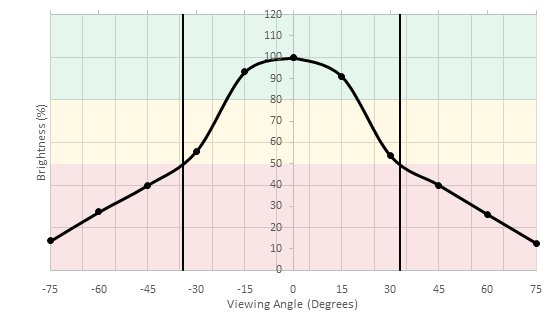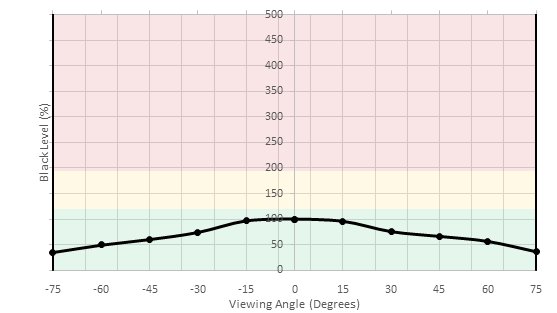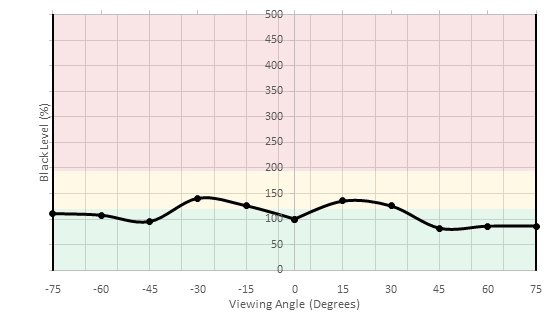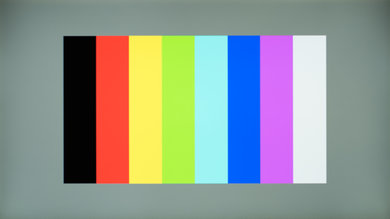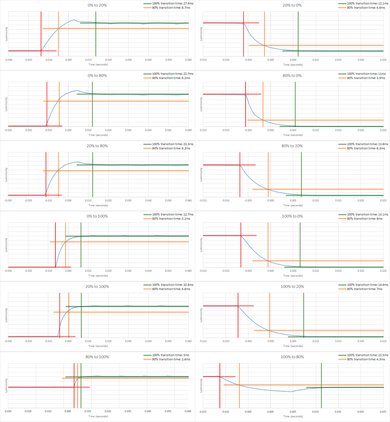The HP V320 is a budget 1080p IPS monitor with average motion and slightly below-average picture quality. It doesn't really exceed at anything, but also doesn't have any huge flaws. The input lag is quite low for a 60Hz monitor, so it feels responsive. Motion blur and gray uniformity are also great.
Our Verdict
The HP V320 is an alright monitor for a range of usages. Picture quality is below average, but the monitor can get bright to overcome glare and the gray uniformity is great. The image also remains accurate at an angle, which is great. Some temporary image retention is visible; however, this is unlikely to be an issue. The motion blur and input lag are great so it feels responsive.
-
Image remains accurate when viewed at an angle.
-
Good motion blur and input lag.
-
Black uniformity is poor.
-
Very low pixel density due to resolution and screen size.
The HP V320 is okay for office use. The larger size is a bonus, however, the 1080p resolution means that it doesn't have any more usable area than smaller monitors. The picture quality is below average, but it does remain quite accurate when viewed at an angle which is good for sharing images with coworkers. Unfortunately, the stand has limited mobility so it can be hard to find a comfortable viewing position.
The HP V320 is a decent monitor for gamers. The HP 320 feels responsive due to the low motion blur and input lag, however, not as responsive as some other monitors due to the 60Hz refresh rate. The response time can be adjusted as preferred, which is also great. Unfortunately, the picture quality is below average and it doesn't support more advanced gaming features such as FreeSync or the ability to flicker the backlight and clear up motion.
The HP V320 is only okay for watching movies and TV shows. Picture quality is below average due to low native contrast ratio and poor black uniformity. The monitor can get quite bright to combat glare, but reflection handling is below average so direct reflections can be distracting.
The HP V320 is mediocre for editing photos or videos. Picture quality is below average, and colors are quite inaccurate out of the box. The HP 320 is worse than most other monitors at handling reflections but it can get quite bright to overcome glare.
The HP V320 doesn't support HDR or a wide color gamut.
- 6.7 Mixed Usage
- 6.8 Office
- 7.0 Gaming
- 6.6 Multimedia
- 6.4 Media Creation
- 5.2 HDR Gaming
Changelog
Check Price
Differences Between Sizes And Variants
We tested the 32" model (V320), which is the only size available.
If someone comes across a different type of panel or if their HP V320 doesn't correspond to our review, let us know and we will update the review. Note that some tests such as the gray uniformity may vary between individual units.
| Model | Size | Refresh rate | Resolution |
|---|---|---|---|
| V320 | 32" | 60Hz | 1080p |
Compared To Other Monitors
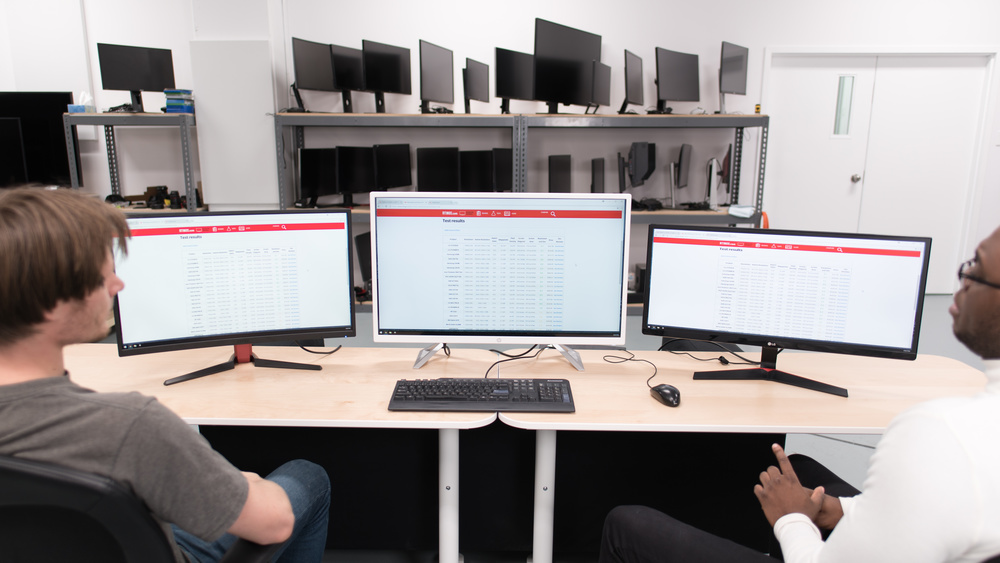
The HP V320 is a budget monitor which offers great value for size but the picture quality is sub-par.
The LG 29UM69G-B is somewhat better than the HP V320. The LG 29UM69G-B has marginally better reflection handling, so it is better if you place it in a room with many light sources. The LG also has a better refresh rate and better image flicker, and thus motion looks crisper. Finally, the LG 29UM69G-B has a higher resolution and will display more detail on the screen.
The Dell P2217H is significantly better than the HP V320. The Dell P2217H has much better ergonomics that allow you to place it in a comfortable position and also has slightly better reflections so that you do not worry about room lighting. The HP V320, on the other hand, is larger but has the same FHD resolution as the Dell, which means that apart from larger size pixels, you do not get more screen space for work.
The Dell U2715H is much better than the HP V320 for every usage. The Dell U2715H has much better ergonomics so you can position it easily as you like. It has higher resolution and can display more details regardless of the smaller screen size. Finally, the Dell U2715H has better reflection handling so you can place it in a brighter room without any issues.
The Dell U2415 is significantly better than the HP V320 in all usages. The Dell U2415 has much better ergonomics so you can easily place it as you prefer and this is a big plus for most usages. The Dell U2415 can handle reflection better so you can place it in a room with a few light sources without worrying about having to rearrange the lighting. The HP V320 is a much larger monitor, though.
The HP V320 is much better than the Sceptre C325W. The HP V320 has a lower input lag and a faster pixel response time that only leaves a small blur trail in fast action scenes which is great if you play games. It also has wider viewing angles because of its IPS panel, so you can show your work to your colleagues easier. On the other hand, the Sceptre C325W has better reflection handling and is suitable for a room with many light sources.
The HP V320 and the Dell D3218HN both have very similar performance. Their scores on our tests were almost identical and there isn't any single score that differentiates one from the other. One difference is in the input ports where the HP has DVI + VGA, and the Dell has VGA + HDMI. Other than that, they have the same performance but are different brands.
The Dell S3219D and the HP V320 are of different types, and they are better suited for different conditions. The HP V320 has an IPS panel and wider viewing angles that favor collaboration. On the other hand, the Dell S3219D has a VA panel with higher resolution that can display deep blacks in a dark room, supports FreeSync for tear-free gaming, and can handle reflections better.
Test Results
The design of the HP V320 is decent. The wide-set stand is quite unusual for a monitor, but it does provide good, stable support. Unfortunately, it isn't possible to adjust the monitor's height or rotate it which can make it more difficult to share images with coworkers or even find a comfortable viewing position. There is no cable management, and the borders are quite thick which isn't ideal for a multi-monitor setup.
Update 07/02/2021: We previously had incorrectly listed the Height Adjustment as 'N/A' as opposed to '0'. The review has been updated to reflect this change, as the Ergonomics score has dropped slightly.
Update 07/05/2018: There was an error in the Tilt Range (it is actually -10° to 2.5°). The review has been updated.
Unfortunately, the ergonomic adjustments on the V320 are very limited. Only the tilt can be adjusted, so it is necessary to prop the monitor up to adjust the height and results in more difficulty finding the most comfortable position.
The rear of this HP monitor is quite simple but does look good. It looks more like a TV from the back, and certainly won't stand out in any room. There is an included metal bracket that replaces the stand with a VESA mount, see here.
The HP V320 does not have a local dimming feature. The video is for reference only.
The HP V320 has a good peak brightness, which helps to overcome glare and ambient light. The brightness stays constant over time and doesn't change depending on the screen content which is good.
HDR is not supported.
Mediocre horizontal viewing angle. Blacks remain almost perfect, but brightness and colors degrade noticeably near the edges of the screen.
Decent vertical viewing angle. The black level remains fairly consistent, but brightness and color degrade a bit near the top and bottom of the screen.
The screen is very uniform, which is great when viewing large areas with uniform colors such as browsing the web, watching content on YouTube, or playing games. Only the corners of the screen have significant variations in brightness, so very little dirty screen effect is visible when watching sports.
When viewed in a dark room, the black uniformity is quite poor. Some flash lighting is visible in the corners, and clouding is present closer to the center of the screen. This may be an issue with dark content in a dark room, but otherwise won't be noticeable.
Out of the box, the HP V320 monitor has a sub-par accuracy. The white balance dE and color dE are both between 4 and 5, which at this level is noticeable by most enthusiasts. The gamma is at 2.06, which is lower than our 2.4 target and the gamma curve is not tracking very closely the target curve.
The HP V320 does not have 'Picture Mode' per se, but you can choose the color temperature mode, and the 'Custom RGB' color mode was the most accurate of them all. So if you don't plan to calibrate your monitor, use this mode to have the best result.
After calibration, the accuracy of the V320 is excellent. The white balance dE was brought down to a negligible 0.58 and the color dE to 0.81. In both cases here, this level of inaccuracy is almost unperceivable. The gamma was corrected to track our 2.4 target, and the curve now is almost perfectly tracking again the target curve.
You can download our ICC profile calibration here.
The HP V320 covers standard gamuts well. The great majority of the s.RGB color space is well represented, with a slightly restricted green primary. Its Adobe RGB capabilities are a bit more limited, however, reducing the monitor's usefulness for more professionally-oriented tasks.
Excellent SDR color volume. The HP V320 has no issues covering the standard s.RGB volume properly. Its lesser coverage of the Adobe RGB color volume due to saturation limitations, unfortunately, make it less suited for photographers that use this larger volume.
HDR gamuts are not supported.
HDR color volumes are not supported.
Some minor image retention is visible after our strenuous 10-minute burn-in scene. This is unlikely to be much of an issue in normal use.
Response Time Level 1
Response Time Level 2
Response Time Level 3
Response Time Level 4
Great response time, good enough for playing fast paced action games or watching sports with quick movement. The response time can be modified by changing the 'Response Time' (Overdrive) setting. We recommend using the 'Level 3' setting for fast response with minimal overshoot. The 'Level 4' setting adds noticeable overshoot (visible as a inverted blur following moving objects) and is only a little faster, so we do not recommend using it.
Like most monitors, the HP V320 doesn't flicker and shows each image for a full frame. Without flicker, motion appears slightly smoother which is good, but persistence blur is more visible due to the static frame time of 60Hz content. Unfortunately, this monitor doesn't have a BFI setting to reduce persistence blur by adding flicker, which is otherwise useful to reduce blur when playing fast-paced games.
The HP V320 only has a fairly common 60Hz refresh rate and has no Variable Refresh Rate features like G-SYNC and FreeSync, which means motion in video games won't look as good as on 144Hz monitors. This is less of an issue when watching TV shows and movies though.
Excellent low input lag, especially for a 60Hz monitor. Non-native resolutions also have the same low input lag, which is great.
The large screen size, coupled with a 1080p resolution, results in a fairly low pixel density. This means that despite the large size, it is not possible to multitask as efficiently as on a higher resolution monitor.
A few additional features are accessible through the monitor's menu:
- Low blue light setting
- Dynamic contrast setting to raise blacks
- Sharpness of the image
- Sleep timer
Comments
HP V320: Main Discussion
Let us know why you want us to review the product here, or encourage others to vote for this product.










